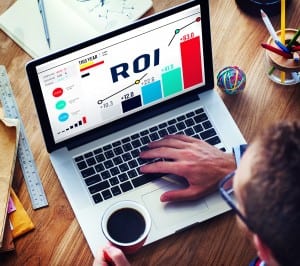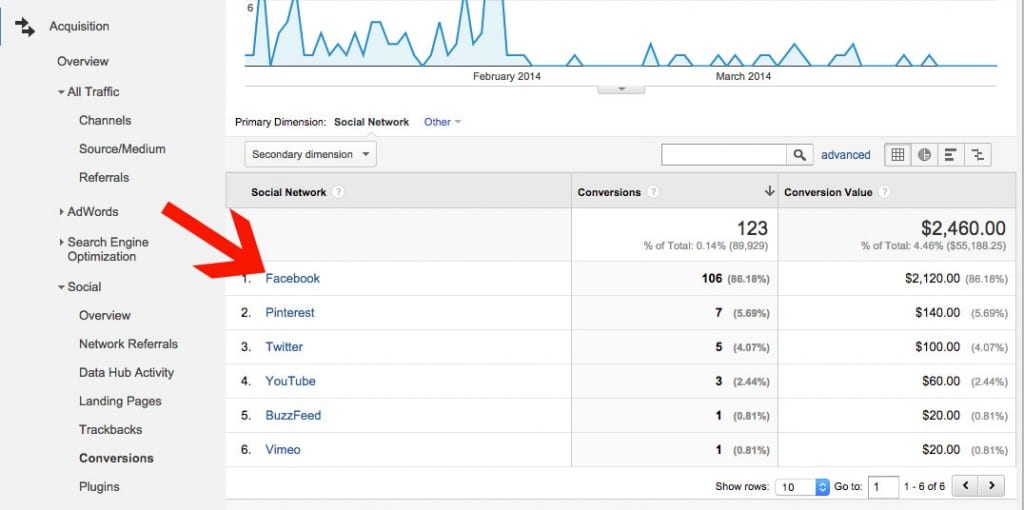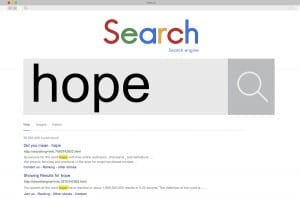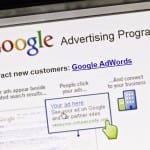Return on Investment or ROI in Travel and tourism digital marketing is one of the biggest mysteries we are facing collectively as an industry today. Our recent Tourism Marketing Plan Blueprint questionnaire confirmed that it is one of the main issues many of us in the travel and tourism industry are struggling with.
 At MyTravelResearch.com, we advocate evidence-based marketing practice, and ROI in travel certainly comes under this banner.
At MyTravelResearch.com, we advocate evidence-based marketing practice, and ROI in travel certainly comes under this banner.
You should not be spending money on marketing where you do not track your spending. Metrics are not perfect, but you should also understand that if you don’t measure your marketing efforts, you are relying on “hope” marketing. This is a dangerous business in today’s marketing environment – you just can’t be sure whether or not your efforts and spending are successful. Just as importantly, you may be diverting resources away from other, more successful, opportunities and risk your ROI in travel digital marketing.
Broadly speaking, though, we find there are generally two camps in the travel and tourism business:
- Those who spend and don’t measure, relying solely on ‘hope marketing’ – spending marketing time and budget and ‘hoping’ it goes well.
- Those who have all the metrics in place, but don’t do anything with it for any number of reasons – lack of time or know-how perhaps.
It can be a difficult area, but what we often tell our clients is that we need to strike a balance between best practices and the real world. It is not always black and white, particularly in areas like social media, PR, and brand equity. We often ask: are you measuring the right things?
We encounter a lot of wastage of precious budgets. An area that upsets me most is consumer travel trade shows, where it’s common for leads to not be followed up. On many occasions, I have seen garbage bins at the exit of some of these travel shows filled with brochures!
There is no true way to measure these sorts of tactical executions of your budget. In the digital age where it is easy to truly connect with interested travellers, one must question the ROI of every dollar and hour spent on a campaign.
Neil Patel tells us that while individual metrics don’t always tell the whole story by themselves, combined together, they can provide you with the whole picture. In the first instance, you need to determine exactly what you are measuring and align this to your broad strategic business goals.
 What are you measuring? What are your goals?
What are you measuring? What are your goals?
Measuring results in relation to your broad and overall business goals should be at the centre of all of your metrics. In the travel and tourism industry, it could include:
- Increase revenue
- Increase visitation
- Increase spend
For the purpose of this article, we will look at two areas of measurement common to the travel and tourism industry – websites and social media.
How to measure ROI on your website?
In the digital age, your website is your shopfront and your face so a critical measurement of the usefulness of your website is important in tracking your ROI in travel & tourism digital marketing. Many businesses do this, but do they do it to any effect? First, you need to broadly define the goal and purpose of your website – and more directly, your conversion goals. These need to drive what you measure. Realistically, as a time-poor travel professional, you won’t be able to apply this to everything, but you should measure what is most important to the broad goals of your business and website.
Eric Enge of Stone Temple Consulting determines that a successful website tracking strategy should go through the tracking cycle. Google Analytics makes it easy (and free) to measure and track your website stats. It also allows you to link them to specific goals, as well as broader goals with a monetary value.
The tracking cycle
- Determine your overall strategy, with both long and short-term goals or objectives.
- Establish a baseline by recording your data and statistics. Compare year-on-year data and take into account seasonal fluctuations, operating environment, and competitive landscape.
- Proceed with tactical execution.
- Collect data over a period of time.
- Compare baseline data to the new data. This could be a particular timeframe, such as 6 or 12 months, etc.
- Refine and adjust your campaign.
Examples of broad goals to measure on your website could include:
- Generating sales
- Generating leads
- Generating revenue
- Travellers to read your blog posts
- Developing an audience
More specifically brand goals include:
- Viewed a pricing page
- Online purchase
- Filled out the contact form
- Usage of online quote feature
- Click on the link to the dealer’s website
- Sign-up to newsletter
- A download of .PDF file
- Time spent on an important webpage
- Social interaction (share/like/follow)
- View of video
- Number of visitors to the site
- Pages – performance over another
- Traffic by search engine
- Traffic by keyword
- Traffic via mobile
- Geographic location
- Images
- Plus, much more.
You can also measure branded traffic. Branded traffic is when a traveller searches using your business or destination name, or types your domain name directly into the search bar.
Once you have determined your goals, time frame, and baseline, proceed with the campaign and collected data, then analyse. You can then go on to tweak and refine your campaign or goals. Rinse and repeat.
How to Measure ROI on Social Media?
The importance of social media for the travel and tourism industry, and in fact all industries, has grown in the past  18 months, with search engine algorithms switching to semantic search. It is important to note that in the world of semantic search, social media plays an increasingly important role in your SEO too. It is not just about being social anymore, so utilize it to maximize your ROI in travel & tourism digital marketing.
18 months, with search engine algorithms switching to semantic search. It is important to note that in the world of semantic search, social media plays an increasingly important role in your SEO too. It is not just about being social anymore, so utilize it to maximize your ROI in travel & tourism digital marketing.
In his book The Art of SEO, Eric Enge states that while SEO and social media marketing are two distinct practices, the influence of social media behaviour on search results will continue to be an important consideration.
He also tells us that although the structures and interaction method varies among social media platforms, it is useful to consider that the main focus is to create and foster relationships.
In this context, you should not be expecting direct sales as an ROI from your social media account, particularly for the travel and tourism industry where consumers are often faced with a high-involvement purchase.
An effective use of social media results from building relationships with your potential customers and building your brand’s trust, reputation, and authority.
It is best to avoid using social media as a direct selling tool with overt advertising. Travellers are looking for authentic and genuine engagement with your brand. Being too ‘salesy’ can often be a disappointment to your existing and potential customers.
Nevertheless, handled well and used in a social context (as it is supposed to be) social media can be a powerful way to ensure you are in the consideration set when it comes to deciding where to go and what to do.
The role of social media is to contribute positively and provide authentic content that is deemed genuinely useful and interesting to your target audience.
If you are a hotel, for example, you may want to look at providing ‘local’ tips on your destination or news on upcoming events. Often events can act as a trigger for the traveller to embark on the path to purchase.
Try to ensure that as well as simply posting content on social media, your strategy includes engagement and real conversations on the topic.
The very first thing you need to do is determine your social media goals. What exactly do you want to achieve?
Once you have determined these goals, you need to determine the right platform(s) for your business or destination. Where do your existing and potential customers hang out? How much time do they spend on the platform?
Keep in mind, it is no use being everywhere if you cannot efficiently service the platform. If you are time-poor, choose one or two social media platforms you know will work for your business or destination. At this point you also need to consider algorithms that may restrict your streams, for example in the case of Facebook, are you willing to attach a budget to the posts?
Here is a great infographic from Melissa Leiter to help you make your decision:

Neil Patel tells us there are several measures of social media available to you, from the obvious to the more subtle. These can be tracked in a simple spreadsheet, Google Analytics (free), your social media account tracking metrics dashboard, or more sophisticated solutions like Buffer.
Social Media Factors to measure include:
- The number of followers you accrue over time.
- Post reach and impressions – getting as many people to see your posts as possible. Most social media accounts have this information available in the account analytics.
- Engagement and click-through rates. This is the number of people interacting with your posts – commenting and sharing. But, ultimately the clicks need to lead to interest via your website. This one can also directly impact your SEO by generating traffic to your website. You can measure clicks to your site from your social media accounts on Google Analytics.
- Time spent on the page. This information is available through Google Analytics via leads to your site.
- Perhaps the most important aspect. Google Analytics makes this easy. Go to “Acquisition > Social > Conversions” and click the button to set up goals (if you haven’t already). Google Analytics allows you to set goals, for example, referrals from Facebook to your website.

Source: (Neil Patel)
If you are achieving a reasonable number of click-throughs, it means your followers are engaged with and enjoying your content – it is useful and relevant. If not, then you need to look at what works compared to what doesn’t work and change your content strategy.
Use the tracking cycle to help tweak and refine your social media campaign and goals. It is important to consider that you will need to change along the way. Look at what performs well and try to emulate that type of content. Ditch the content that no one engages with. Try to come up with a content formula that works well for you.
This blog piece is just a taster. We plan to incorporate a full ROI in travel supplement resulting from your feedback into our Tourism Marketing Plan Blueprint, with tips on how to measure ROI.
Do you want to hear more from us?
Want to be kept up to date with the latest travel and tourism insights? Join Our Mailing List. Every 2 weeks, we send the latest practical insight for you to apply to your business and destination marketing.

 What are you measuring? What are your goals?
What are you measuring? What are your goals?



Hi Bronwyn,
Thank you for the insightful article.
May I ask, how does one actually calculate the ROI for digital marketing, specifically for tourism? Is there some sort of formula? Can one “cost” the activities per rand (ZAR) value? We are trying to quantify and calculate marketing services as a Destination Marketing Company i.e the cost of advertorials, articles posted online, video’s posted etc. because we need to see what investment was made? If we provide funding for a tourism organization, we need to see what we were “buying” in rand value? How do we quantify the cost of services. How does one do this?
Chrismare
Thanks for the great question. This is such a broad field. As always with these things and as Bronwyn says it starts with your objectives. When spending this money what exactly were you trying to achieve. There certainly are formulas and if your project was to drive bottom of the funnel conversion (bookings, sales, revenue) then these can be very useful Here is the formula and some tools to help with this https://www.smartinsights.com/digital-marketing-strategy/6-tools-help-prove-your-marketing-roi-month-by-month/
However, there is a lot of evidence that suggests you also need longer term activities that build brand which makes your short term efforts more effective. Check out https://www.marketingweek.com/mark-ritson-funnel-juggling-marketing-effectiveness/ For this, you need to look at both long and short term goals. Ritson’s recommendation is that you actually should set different budgets and measures for these and I agree. In fact, if I could I would treat long term brand building as capex not opex. For the latter you are measuring longer term gains like revenue growth or market share.
So all the toels Bronwyn mentions and all the approaches in these articles are relevant.
Chrismare… I thought this might also be useful. It tells you how to construct your own marketing model (well you fill in the form to continue) obviously the firm is promoting their own solutions but I find the thinking can still be helpful https://www.marketingweek.com/knowledge-bank/view/how-to-build-an-in-house-marketing-mix-modeling-capability/?cmpid=em~mktg~knowledge_bank~n~n&utm_medium=em&ut
Hi Author!
I really like your blog and become a fan of your blog, I love the way you wrote this content. Thanks for sharing such great information with us.
Very useful article! Thank you for sharing.
Glad you enjoyed it!
Excellent article !
Hi Mark
Thanks for taking the time to reply, I am glad you got something out of it.
Bron